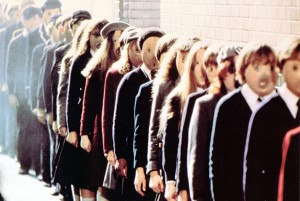
Who gets to enroll in your school?
This question is at the heart of the charter school debate.
While traditional public schools have to accept any student who meets residency requirements, charter schools can be entirely more selective.
They don’t have to take just any student. They can pick and choose based on pretty much whatever criteria they want.
Despite the fact that charters are publicly funded and privately run, transparency requirements are so low in most states that regulators aren’t even allowed to check up on their enrollment practices.
It’s a situation rife with the potential for fraud and abuse with America’s most vulnerable students often being victimized and huge corporations raking in record profits.
Critics say that charter schools routinely accept only the easiest students to educate. They take those with the best academic records, without disciplinary problems or special education needs. This allows them to spend less money to run their schools and claim all their students are doing well because of artificially inflated test scores.
But when critics level such charges against the charter school industry, the most common reply is an appeal to charter school lotteries.
When these privatized schools get more applications than they have seats, they often resort to a lottery to determine which students get to enroll.
The infamous propaganda movie “Waiting for Superman” had a much quoted scene where poor children held onto their lottery tickets as they hoped and prayed to be saved from a “failing public school.”
Advocates claim this is what makes charters fair: Students get in by pure chance.
But it’s not true.
More often than not, whenever enrollment data is available, it shows that charter administrators are, in fact, selective.
Take BASIS School Inc., a charter chain with 18 schools in Arizona, three in Texas and one in Washington D.C. The chain’s schools in Tucson and Scottsdale are highly ranked on Newsweek’s “America’s Most Challenging High Schools” list, and on the Best High Schools list of U.S. News & World Report.
However, their enrollment figures show them to be out-and-out cherry pickers.
They typically over-enroll Asian-American students and under enroll Latinos. They also enroll a much lower proportion of special education students than the state average and – shockingly – have zero English Language Learners.
Despite corporate accolades, this is not a successful model of public education. It is prejudicial, exclusionary and entirely the goal of for-profit educational institutions everywhere.
But besides outright corruption from charter administrators, there are other factors that suppress the neediest students from even applying to charter schools.
In short, they don’t want to go to these types of schools. They can’t afford losing the services and amenities they would typically receive at traditional public schools. They can’t afford the extra out-of-pocket costs charters demand.
Frankly, many charter schools are set up for middle class or wealthier students. Even if accepted, the poor would get fewer services and be forced to pay more than they could afford.
1) They Can’t Afford Uniforms
Many charter schools require students to wear uniforms. Most traditional public schools do not. Therefore, even though your local charter school is funded by tax dollars, it can be a hefty financial burden to attend.
How much more does it cost? That depends. Each charter school has different requirements.
For instance, in the New Orleans Parents’ Guide, the cost for a single uniform is estimated at more than $70. That’s at least $350 for a week’s worth of clothes. However, many estimates I’ve seen have been much higher.
Many charters require students to wear blazers – something a traditional public school student wouldn’t be caught dead wearing. These are pretty expensive items. They can cost anywhere from $80-$250 each.
Moreover, some charters, like most in the KIPP network, require everyday items like socks and shirts to contain an embroidered school logo. That’s at least an additional $10-15 per item.
For impoverished parents who routinely shop at local thrift stores or the Salvation Army, charter school uniforms can put them out of reach.
To be fair, about 19% of traditional public schools also require uniforms. However, they are typically much less expensive. In fact, they rarely amount to more than requiring clothing to be of a wide variety of colors and/or styles.
And if parents can’t afford the extra cost, traditional districts are required to either forgo the requirement or help parents meet it. They cannot deny children an education based on their parents inability to buy uniforms. Charter schools, on the other hand, can.
2) They Need Special Education Programs
Charter schools are rarely – if ever – known for their special education programs. Traditional public schools, on the other hand, are renowned for meeting the needs of diverse students with various abilities. If your child has special needs, going to a charter school simply may not be an option.
One reason for this is the basic structure of each type of institution. Traditional public schools are usually much bigger than charter schools. As a result, they can pool their resources to better meet special students needs.
At charter schools nationally, disabled students represent only about 7-8% of all students enrolled. At traditional public schools, they average a little more than 11%, according to a Government Accountability Office analysis of Department of Education data. So traditional public schools already have the staff, infrastructure and experience to help these children. Moreover, it would be cost prohibitive for charters to add them, especially when they’re designed specifically to make a profit.
Perhaps more troubling is this: charter schools rarely identify students as having special needs. Students who would get extra help and services in a traditional public school setting, do without in charter schools. In fact, parents who feel their children’s needs aren’t being met at charters, often disenroll them and place them back in their traditional public school for the extra help.
Parents with students who have learning disabilities or extra needs simply can’t afford letting their children languish in a privatized school setting that may well ignore their child’s individual needs.
3) They Need Free/Reduced Breakfast and Lunches
Though the state and federal government pay for free or reduced breakfast or lunch programs, charter schools often don’t offer them. Traditional public schools do. It’s that simple. If you’re having trouble feeding your children, sending them to a charter school can mean letting them go hungry.
Take Arizona. Statewide, more than 47% of all students receive free or reduced-priced lunch. However, charter schools in the BASIS network have none. This doesn’t mean none of their students qualify. Clearly some of them do. The BASIS chain has chosen not to participate.
Why? Perhaps it’s to keep away students who have greater needs.
If so, it’s working.
Even when charters don’t actively weed out hard to teach students, they can set things up to make them less likely to apply.
4) They Need Busing To-And-From School
Often students don’t live within walking distance of their school. Traditional public schools routinely provide busing. Charter schools often do not. If you can drive your child to-and-from school, this is not an issue. If you’re poor and don’t have your own means of transportation, this is an added burden.
And if you think this is only a feature of the most fly-by-night charters, think again. The BASIS network – again, which includes some of the highest rated charters in the country – does not provide busing.
Traditional public schools are often at the heart of the community. They spring up around community centers, parks, and social gathering places. Charter schools are more often located at new or repurposed sites that can be miles away from the people they serve.
When the traditional public school offers a free ride to-and-from school, it can be an insurmountable burden to go to a charter where you have to find another way to get there. Parents who are working multiple jobs and/or the night shift may find it impossible to take their kids to the local charter. But perhaps this is exactly why charters aren’t offering busing in the first place. They don’t want these children.
5) They Don’t Have Time and/or Money For Extra Charter Demands
Charter schools demand an awful lot from parents. Traditional public schools do not. While children often benefit from involved parents, that’s not always possible. It’s unfair to require parental involvement as a prerequisite of enrollment.
Many charter schools require parents to volunteer at the school for so many hours a week. They often require “suggested” donations for extra services and for parents to buy books, supplies, or to pay an additional fee for extra curricular activities that would be provided for free at traditional public schools.
The BASIS network, for instance, requests that families contribute at least $1,500 a year per child to the school to fund its teacher bonus program. Families are also required to pay a $300 security deposit, purchase books, and pay for activities that would be free if the student attended a public school.
This is simply out of reach for the most disadvantaged students. Their parents are out of work or working multiple jobs to support them. They can’t volunteer at the school when they have to serve a shift at WalMart. They can’t afford the additional costs.
So, yes, charters often select against the poorest and neediest students when deciding whom to enroll.
However, even when they conduct fair lotteries to determine enrollment, they often set things up to discourage the neediest families from even applying in the first place.
NOTE: Special thanks to Priscilla Sanstead on this article.



